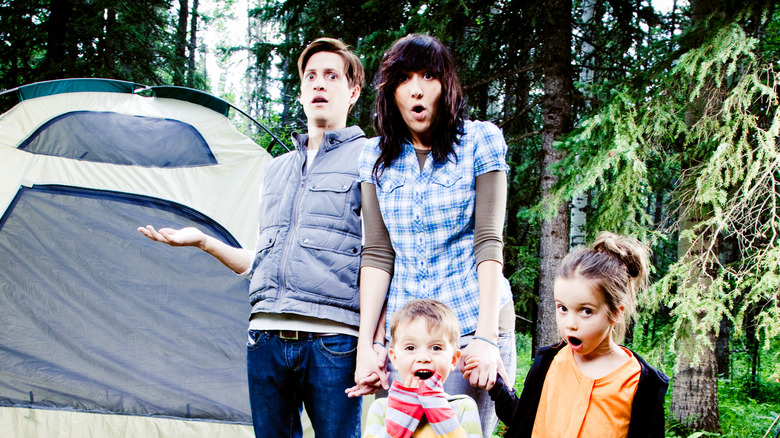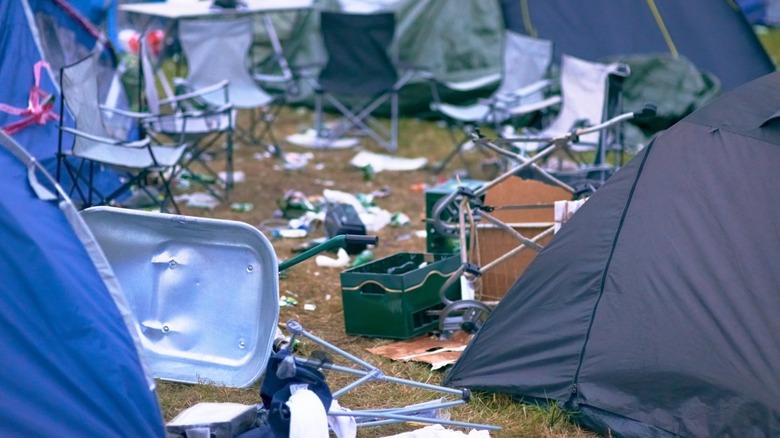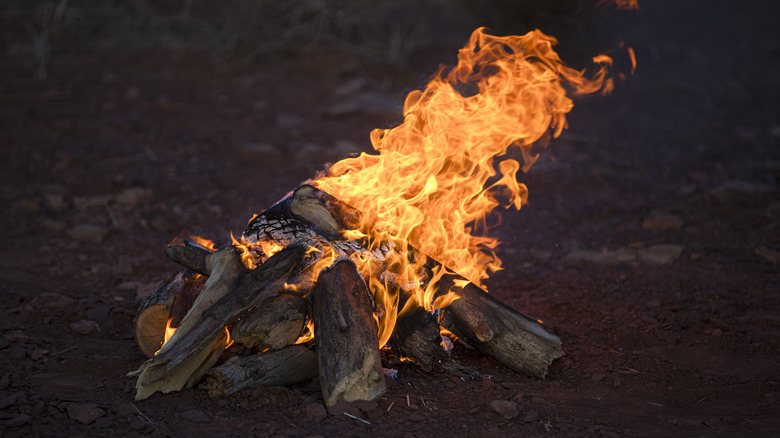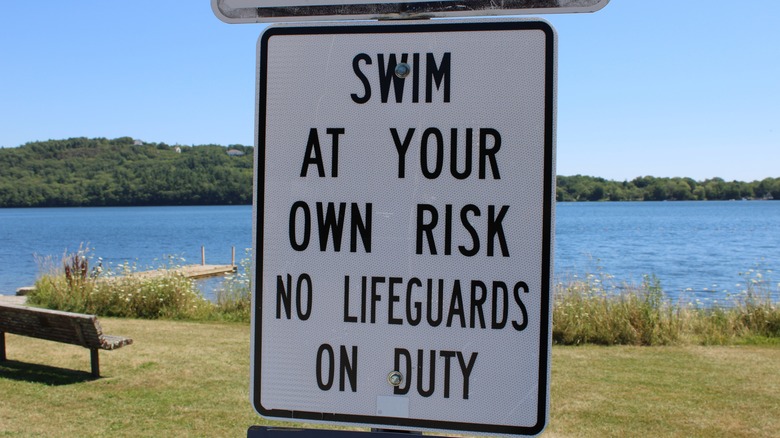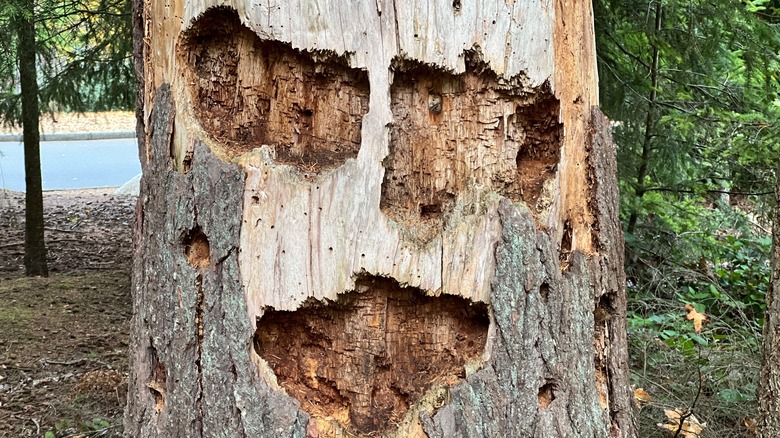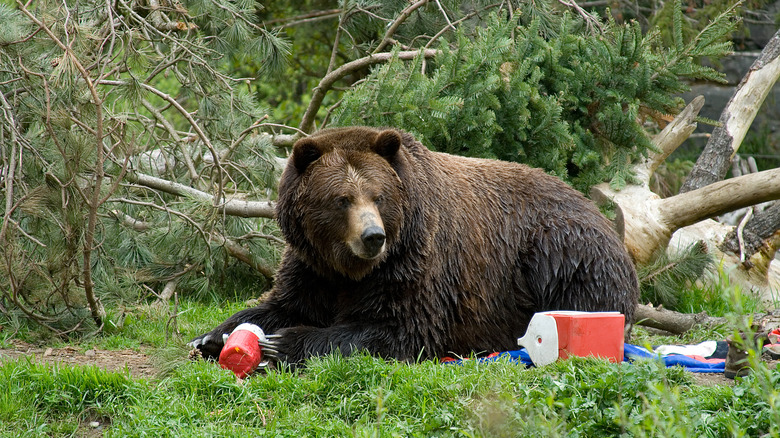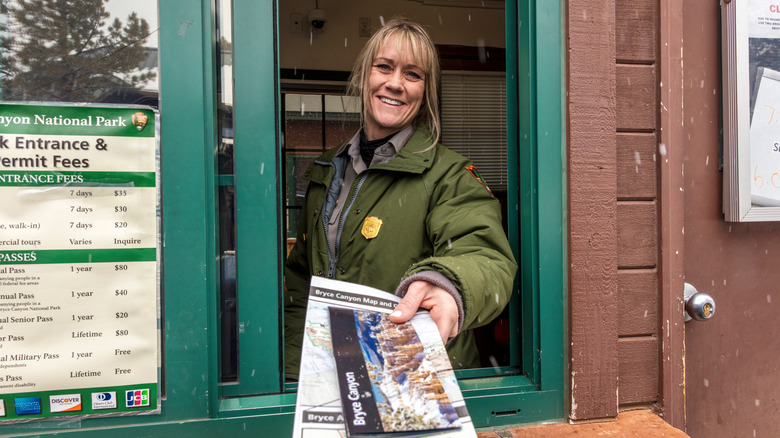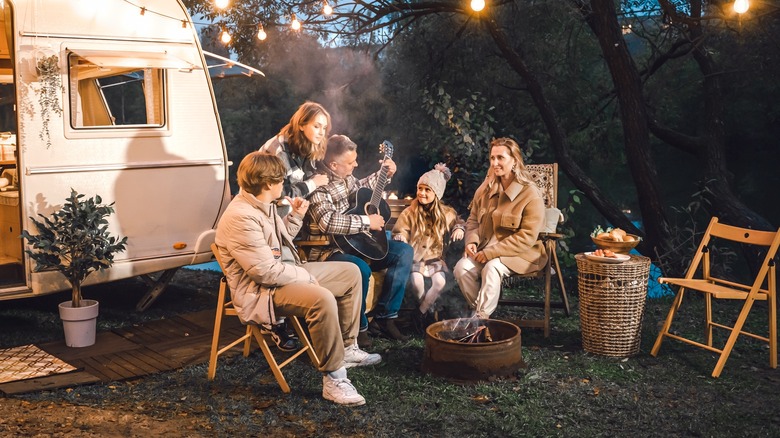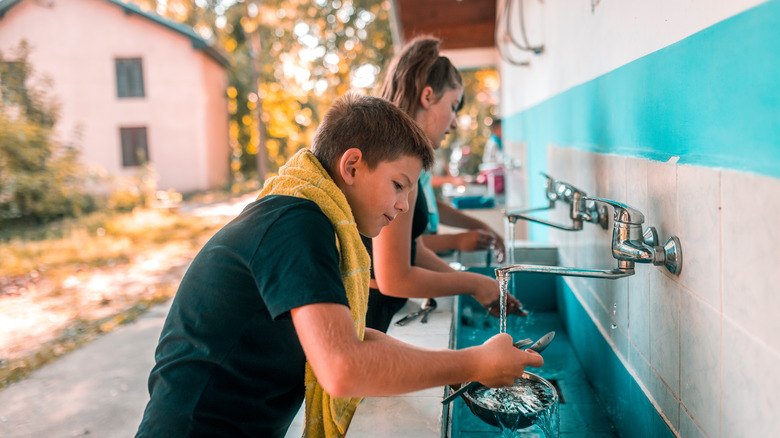Red Flags At Your Campsite That Could Mean Big Trouble
A favorite American pastime, more people are going camping than ever before. According to The Dyrt's 2023 Camping Report, there are an estimated 80 million campers in the United States, 7.2 million of which are new to the activity. As such, it's important for the newbies, or even seasoned pros, to be aware of red flags that could mean trouble for your campground.
By definition, a red flag is a warning sign that points to a potential problem. While there are literal red flag warnings instituted by the National Weather Service to indicate hazardous weather conditions, when it comes to campsites, the red flags might not be immediately obvious. This list of red flags will keep you informed when planning your next camping trip.
A good camping trip is not merely about spending time in nature. It's also about making sure that wherever you're camping is actually safe. So, whether it's poor signage, improperly spacing around campfire pits, dangerous trees, or the presence of wildlife, the following 10 red flags are ones that could potentially mean serious trouble for your crew.
Tentsite hazards could mean camping discomfort
This first red flag is one that could happen at any site, whether you're out in the wilderness or at a privately owned campground. Tentsite hazards are ones that can lead to camping discomfort, and are one of the first things to indicate troublesome times ahead. These hazards could be left by previous occupants, or come from nature. Either way, you're looking at some fairly uncomfortable situations moving forward.
When you arrive at your tent site, check the surroundings and see if there is anything untoward. There could be trash, broken glass, or other dangerous litter left behind by a previous occupant. It is also good to check for evidence of wildlife or insect infestation. You don't want to be setting up your tent on a highway for either. Standing water is another issue, as it indicates improper drainage for your site and the likelihood of mosquitos.
Some of these, like trash left behind, can easily be cleaned up. However, if you've paid for a campsite, you don't want to have to worry about whether or not you're going to step on broken glass, and have to deal with water or bugs in your tent. The lack of maintenance on part of the owner of the campground could mean even more trouble.
Be aware of non-existant or out-of-date signage
Regardless of whether you're camping at a national park or a small, independently financed campsite, there needs to be clear, up-to-date signage. Signage is incredibly important for campers and campsite owners. For campers, signs provide information about potential hazards, dangerous wildlife, campsite rules, speed limits, and other safety concerns. For owners, signs are a magnificent tool to aid in the prevention of liability lawsuits.
If the signs at a campsite are faded to the point of being illegible, provide out-of-date information, or are otherwise non-existent, it could mean two potential red flags for incoming campers. One, the site in question might not have the insurance necessary to cover its legal costs in the case of tragic events. Or, they simply don't care. While it is more likely the former, either could mean trouble for campers if anything bad occurs.
It's important for campers to know that the campsite they are patronizing prioritizes their safety. If the site is indeed without requisite insurance, should something go wrong, the camper might have to pay money out of pocket even though they were not liable.
Campfire pits need at least 15' of clearance
Once you've cleaned up your tent site of any debris, it's time to see whether or not there is proper spacing around the campfire pit. As a general rule, there should be a least 10 to 15 feet of cleared space surrounding the fire pit. This is to ensure that, should the fire spread out of control or spark excessively, there is minimal risk of it causing excessive damage to campers property or the site at large. You don't have to literally measure the radius around the fire pit, but you can pretty easily tell by eye whether or not there is enough space around the pit.
If the fire pit does not have sufficient clearing, the risk of a fire hazard increases. Tents have never been known for their anti-flammable qualities. Whether made of canvas or polyester, one too many sparks could lead to potential disaster. The same is true if the fire pit is situated too close to the woods.
According to the Western Fire Chiefs Association, 90% of all wildfires in the U.S. are caused by unattended campfires. Though there is no statistic to prove it, there is a decent chance a good few of these campfires were built too close to the woodside, where dried needles, twigs, and leaves were all too happy to serve as food for a growing fire. Pay attention to your campfire, and make sure there is not too much surrounding it.
Bodies of water require proper safety
This is a red flag that really only applies to established campsites, as we cannot expect there to be adequate signage at the random watering hole in the middle of nowhere. It is incumbent upon any campsite with a water feature, whether a pool or a pond/lake, to provide necessities for water safety. These include but are not limited to life jackets, lifeguards, adequate docks, and proper signage. Failing to do so is negligent on the part of the owner, as not having these provisions could put campers at serious risk.
Now, if a campsite is smaller and does not have the funds to staff lifeguards, a "Swim at Your Own Risk" sign is adequate to avoid potential lawsuits. As a camper and swimmer, it is important to keep that in mind should an accident occur. It is worth noting, however, that the legal protections of this sign do not apply to children harmed while swimming, per Butler Prather LLP.
There is a certain amount of oneness on the part of the camper to bring swimming safety equipment themselves, but if here is no indication whatsoever that the campsite has done anything to properly ensure swimming safety, that is a huge red flag.
Look out for dangerous trees
Unless you're out camping on the plains or in the desert, chances are you are going to be setting up a tent under a canopy of trees. And why wouldn't you? They provide excellent shade and protection from the wind and rain. However, trees also present their fair share of danger, which is why it is incumbent upon campers to look around their campsite for evidence of any dangerous trees.
When you arrive on the site, be sure to look around for any fallen branches, dead wood, or trees that look rotted. It's also worthwhile to check for evidence of insects or woodpeckers, which are usually pretty obvious as they tend to leave noticeable trails. Any of these factors could pose a major risk to the structural integrity of the tree. The last thing anyone needs is a massive trunk falling on their tent or parked car.
If you are at a good campsite, most of the hazardous trees will have been cleared away by the property manager. However, they cannot get everything. If your site happens to be near a dangerous tree, don't immediately assume negligence on the part of the owner. If the branch is scary enough, you can always see if there is another open site.
Don't underestimate the presence of wildlife
Wildlife can be an enormous problem, figuratively and literally, for all campsites. While campsites that are fenced in tend to have less issues with invading wildlife, that doesn't mean creatures won't show up if properly motivated. Besides, there could be faults in the fence, or even no fence at all. While it's true that wild animals tend to stay away from human crowds, there are some red flags you need to be aware of.
The first is the presence of food. Even if you properly put store your food to keep the likes of raccoons and coyotes away from your campsite, if you've made camp by a patch of wild berries or near a stream flowing with fish, chances are you're going to come across someone who wants to eat those things.
Bears are the primary concern, seeing as they have tremendous appetites for just about anything. However, any campground in bear country that does not come equipped with proper bear-proof food storage is asking for trouble. Keep that in mind too if you're ever camping somewhere like Glacier National Park, where bear sightings are quite frequent.
Don't write off critical online reviews
There are those reviews that are just downright petty. If the campsite promising beautiful sunsets was overcast while the reviewer was there, or their glamping yurt didn't come with enough sparkling water — these are not the types of reviews to fret about. Rather, consider poor reviews with legitimate criticism. These should not be ignored.
If the campsite you are thinking of staying at has enough bad reviews against it, chances are the site in question is not actually very good. See what the reviews are saying. If there are legitimate complaints about safety, tent site quality, facility cleanliness, and the like, you'll want to pay attention to those. These are complaints that actually have some critical legitimacy to them.
Obviously, no campsite is absolutely perfect. Someone is always going to find something to complain about. However, if there are enough critical reviews about problems that give you pause, take it as a sign to look for another campground.
Take note of the professionalism and availability of site staff
There is a lot to be said for customer service. Good customer service is the reason shoppers continue to patronize our favorite stores, so it only makes sense that this mentality would apply to campgrounds as well. If people are returning to their favorite campsites year after year, there's a good chance that more than just the scenery is beautiful. It's likely the site staff are professional and available too.
You can get an inkling of the professionalism of the site staff by looking at online reviews, but experiencing it in person is a far better gauge than anything you read on the web. If you find that the staff are rude, abrasive, obnoxious, and otherwise unavailable, you are not likely to return to the campsite.
However, the lack of availability is also a major safety concern. Say you require an ambulance in the middle of the night, and there is no one at the gate or ranger station available, or willing, to make the call. That poses a potentially life-threatening risk, one you would not be willing to make again by visiting that campground.
No noise regulations could mean sleepless nights
One of the biggest rules of camping etiquette is to keep the noise down during certain hours out of respect to your camping neighbors. Most established campsites will actually have noise regulations, typically stating that camp quiet hours are between 10 p.m. and 6 a.m. This allows for the night to be spent without campers worrying about someone blasting music at all hours. That is, unless the camp has no noise regulations.
This is something that would easily be posted on camp signage or available on the website. If there are no noise regulations to be found, a camper could be in for one or more sleepless nights. The lack of regulation means that there is no enforcement of noise, regardless of the hour. So, if someone is bellowing away with their loudspeakers at 2 a.m., there is no real way to stop them.
Not only is this bad form, it's a bad idea on the part of the campsite owner. Not many people are going to want to stay somewhere where quiet hours are not enforced. Most campers value a good nights sleep.
Check for available amenities
The final red flag on this list is the availability of amenities. Not everyone is going to care all that much about amenities at the campsite, especially those who prefer the backcountry to the more manicured campground. However, for those who appreciate the semblance of civilization, like indoor plumbing, showers, and hookups for RV's, then the lack of amenities are going to cause something of a concern.
Campsites, and RV sites in particular, need things like potable water, hookups, bathrooms, and showers. All of these are, in many ways, considered basic for any campsite, regardless of size. If yours is missing these, or the ones available are unkempt and disgusting, you are not going to be looking to return to or recommend this campsite to anyone.
Now, all of these red flags are easily remedied with proper research. Most who go camping already know them, and first-timers will quickly gain a solid understanding of why they're important.
